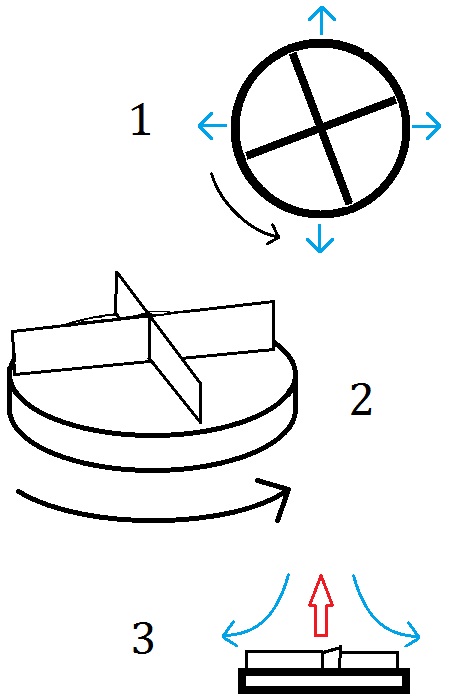I was inspired by Bernoulli’s observation that the higher speed of the air on the top side of an airfoil creates a low pressure zone. The vehicle is then lifted by the higher air pressure beneath the airfoil. My twelve year old brain knew that to make a vehicle fly, I needed to lower the air pressure above the wing surface — essentially, to displace air away from the top — thereby creating a partial vacuum above the vehicle. But there was no rule saying that the displaced air had to end up directly underneath the vehicle.
My crazy scheme was to design a flying machine that would create a partial vacuum on its top surface (which is also what a helicopter does), by displacing the air sideways, rather than downward. The vehicle would be drawn up into the region of lower pressure just above it, and voila, flight.
The diagrams below show roughly what I had in mind. The result looked something like a flying saucer — which is not surprising, considering that its inventor was a twelve year old boy. 😉
The top view (1) shows rotors atop the disk spinning, which creates centripetal force that pushes air (the blue arrows) radially outward. The perspective view (2) is a schematic representation of the rotating blades. In practice a lot of work would need to be done to figure out the right size and shape for these spinning airfoils. The side view (2) shows how air comes in at the top and is then pushed out to the side. The partial vacuum above the vehicle results in lift (the red arrow):

In principle, you could stand right underneath one of these flying saucers and not feel any downward wind force. Of course, as they say, theory and practice are the same in theory, but different in practice. I suspect that by now somebody has long since had a similar idea, has probably tried to build one of these things, and has realized why it wouldn’t really work.
But when I was twelve, thinking about stuff like this kept me off the streets and out of trouble. 🙂
I often wish there was a simple sandbox system you could use to see what would happen with inventions like this. I suspect (but I don’t know) that the air would be pushed over the top of the blades more than out the sides, creating a region of higher pressure above the blades, and pushing the structure down rather than up. This would require a lower speed than having the air flow the length of the blade to emerge from the side, and thus less energy, making it energetically favourable.
However, if those were helicopter blades, then they would produce downdraft, and a conical structure beneath might divert the flow radially rather than vertically. It wouldn’t move very quickly vertically, because of the significant drag from the bottom of the structure, unless the structure tapered back to a point at the bottom.
Less of a flying saucer, more of a flying spinning-top.
I knew some boys like you when I was 12. I admit that I didn’t appreciate them properly back then 🙂
If the rotor is shaped like a screw and is rotating fast enough, it can bore it’s way through the air in any direction.
Phil: Ideally the actual mechanism, whatever its details of construction, would create a smooth laminar flow from an intake on top to vents around the sides. As you said in your other comment, there is indeed a downdraft, but it is distributed over a very wide area, so it does not disturb people standing directly beneath.
Sharon: I’m guessing you’ve become enlightened since then. 🙂
Cadabra: Good point, but who wants a boring screw? 😉
Indeed, in so many ways 🙂
(After I hit submit it occurred to me to say that I didn’t appreciate them improperly either 😉
For twelve year old boy to think about Bernoulli is amazing.
Nature invented this concept in amazing form in the bird flight. Wing flapping birds, pushes their wings downward to create vacuum above their wings and high pressure below bushes them upward. What is more amazing is the upstroke of the wings and how feather makes birds fly more elegantly than the other flying animal. The concept explained in the following video.
http://youtu.be/1kztP_XTEPk